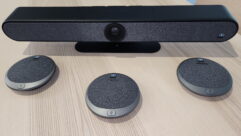
Picture This: The Numbers Game
Jun 1, 2004 12:00 PM,
By Jeff Sauer
I have to concede that when I look at the flat-panel product chart in the “Technology Showcase: LCDs and Plasma Displays” article, I’m troubled. Call me a number-loving, overly left-brained statistics junkie if you like, but I just don’t like seeing that string of “n/a” responses under brightness (and, thankfully less often, under contrast ratio). After all, right or wrong, those numbers are often key decision points for consumers trying to understand and compare products.
The funny thing is that I don’t particularly fault the companies that haven’t reported those statistics. In a way, those companies are taking the more straightforward approach. Generally speaking, there really is no industry standard for measuring and reporting brightness, and, by extension, contrast and bad information, or at least arbitrary information, can be worse than no information. Not reporting brightness stays away from misleading information.
On the surface, that can easily seem like a cop-out: “If you don’t play by my rules, I’m taking my ball and going home.” That can seem especially true with big companies like Sony and Panasonic that, by their sheer size and sales force, can demand attention and a second look. But it’s not that easy.
WHITE LIGHT, WHITE HEAT
As many Sound & Video Contractor readers know, plasma monitors can produce brighter white when that white covers just a small spot on the screen than when the entire screen is full-on white. That’s similar to CRT projectors, but the differences are more significant. With plasma the drop in brightness can reach 50 to 80 percent when the entire screen is bright, and that’s a potentially huge difference under even slightly varying testing conditions.
Not surprisingly, manufacturers that do report plasma brightness generally measure the brightness of a white spot in the center of a black screen, thus offering a peak brightness for the entire monitor. However, if that white spot covers only 5 percent of the pixels as opposed to 10 percent, the brightness specification will increase by some 2 to 5 percent. If the white covers an area that is no bigger than the sensor or measuring device, the specification will jump even more.
I suppose by simply putting stock in any brightness claims, the industry is falling into a trap of its own making. After all, as the adage says, “There are three kinds of lies: lies, damn lies, and statistics.” Of course, customers who buy based on numbers comparisons are simply cutting corners insensibly. There’s a lot more to buying a quality plasma than which product can produce the most light. Color, clarity, sharpness, black level, gray-scale range, deinterlacing, image processing, connectivity options, option accessories, and just the way the image looks are, arguably, more important than brightness.
However, there’s no denying that in the age of information overload, those numbers can act as reasonable guideposts. Particularly in bid situations, prospective buyers have to begin somewhere, and basic information like brightness and contrast often seems helpful, especially when many buyers don’t have the opportunity to see multiple panels side by side.
Yet that reality also means that manufacturers are forced to play a game, as well, hitting certain statistical watermarks lest they be simply omitted from consideration. Awkwardly, that can lead to following or adopting practices that overtly or covertly create the most favorable marketing impression.
That has been the case in the projector industry with the move toward full-on/full-off contrast ratio measurements. Five years ago, it was a lot more common for manufacturers to report contrast ratio as measured using the ANSI checkerboard, a grid of 16 blocks of alternating white and black rectangles covering the entire screen. Today contrast ratio is almost always reported as full on/full off.
There was probably no compelling reason why the checkerboard needed to be the standard. The checkerboard does, in total, fill half the screen with white and half black and thereby may in some way approximate some average potential usage, though it is far more common in ordinary use to have a video scene or data slide that leans much more toward light or dark overall. However, the most important element of most testing procedures for product comparison is consistency, and the ANSI checkerboard is an easily duplicable pattern. Therefore, testers in different labs could feel confident that their measurements would be consistent, within a reasonable margin of error and equipment variation, with those of others. At least they’d be talking the same language, as it were.
The move toward reporting full-on/full-off measurements came as a direct result of marketing, starting a few years ago when DLP projectors started hitting stride, and that’s no coincidence. By the nature of the technology, DLP micromirrors have an inherent full brightness advantage over LCD panels in projection. Given the same lamp, DLP will always produce more light because mirrors reflect light, whereas LCD-based projectors shine light through panels that necessarily block some percentage of the light. Moreover, DLP projectors have also been able to reduce black levels by turning the micromirrors away from the outgoing light path. Blocking more light in dark scenes would, simplistically, mean using LCD panels that blocked more light in bright scenes, as well. Those advantages diminish with “real-world content” that usually mixes lights and darks.
Still, to exploit this inherent advantage, Texas Instruments turned away from the ANSI checkerboard and started reporting full-on/full-off contrast ratios, and the numbers were impressive. Contrast ratios hopped from the 100:1 to 200:1 range to where you now regularly see numbers like 2000:1 to 3000:1. For LCD projection makers, switching from reporting the ANSI checkerboard to full on/full off begets roughly a doubling in contrast ratio, up from 100:1 to 200:1 to the 300:1 to 400:1 range. But unfortunately, if one maker does it, the others have to follow or lose the perception battle with the buying public.
There was nothing inherently dishonest about the move to full-on/full-off contrast measurements. Most often, though admittedly not always, manufacturers specifically reported contrast ratio as full on/full off. Early on that difference was somewhat subtle, easy to overlook on a brochure, and awkward, though today it’s generally understood across the industry that contrast will be full on/full off. I personally still put more stock in the value of an ANSI checkerboard because it seems to better approximate real use, but where it’s more important to bend toward consistency — in projector reviews, for example — I measure and report both.
TAKING MEASUREMENTS
Unfortunately, with plasma brightness, there is no standard. That’s particularly true between plasma and LCDs (see the Technology Showcase on p. 50), but more critically, it’s the case within the plasma industry itself.
That’s not to say there aren’t common testing procedures. For example, it is simple enough to measure brightness with the plasma full on white, though that would be a brightness worse-case for plasmas and thus awkward for both practical and marketing reasons. A more real-world test is to measure brightness in the ANSI nine-point grid for projector testing but by lighting only a third (three horizontal lines top to bottom) or a ninth of the screen at any one time. However, because brightness variation across plasma is less an issue than with projection, those tests would be unnecessarily redundant.
It’s most common to measure the brightness of a white circle in the middle of a plasma. Rather than fight that, the industry ought to settle on it. Ideally, for real-world approximate values, that white circle would be surrounded with gray or some other neutral color rather than black, but even that isn’t particular necessary.
More than anything, consistency needs to be king with statistical measurements, so all that really matters is the size of the white circle. Fortunately, there is historical precedent from the measure brightness of CRT projector days when manufacturers often specifically referred to “10 percent peak brightness.” Sometimes it was 20 percent, but ultimately, it doesn’t really matter as long as it’s consistent.
If plasma makers began reporting 10 percent peak brightness rather than just brightness, the industry would immediately (some terminology education excepted) have a better understanding of what that specification meant rather than looking at it as space on a brochure page. It’s likely that many brightness claims wouldn’t change, because that 10 percent circle is a common general guideline, and many manufacturers already test that way. However, formalizing 10 percent peak brightness would mean consistency, and that would, in turn, yield the trust and understanding of the buying public.
Jeff Sauerwrites the “Picture This” column for Sound & Video Contractor and is a contributing editor for Video Systems. He’s a video producer, an industry consultant, and the director of the Desktop Video Group, a video and computer products testing lab in Cambridge, Massachusetts. He can be reached at[email protected].









